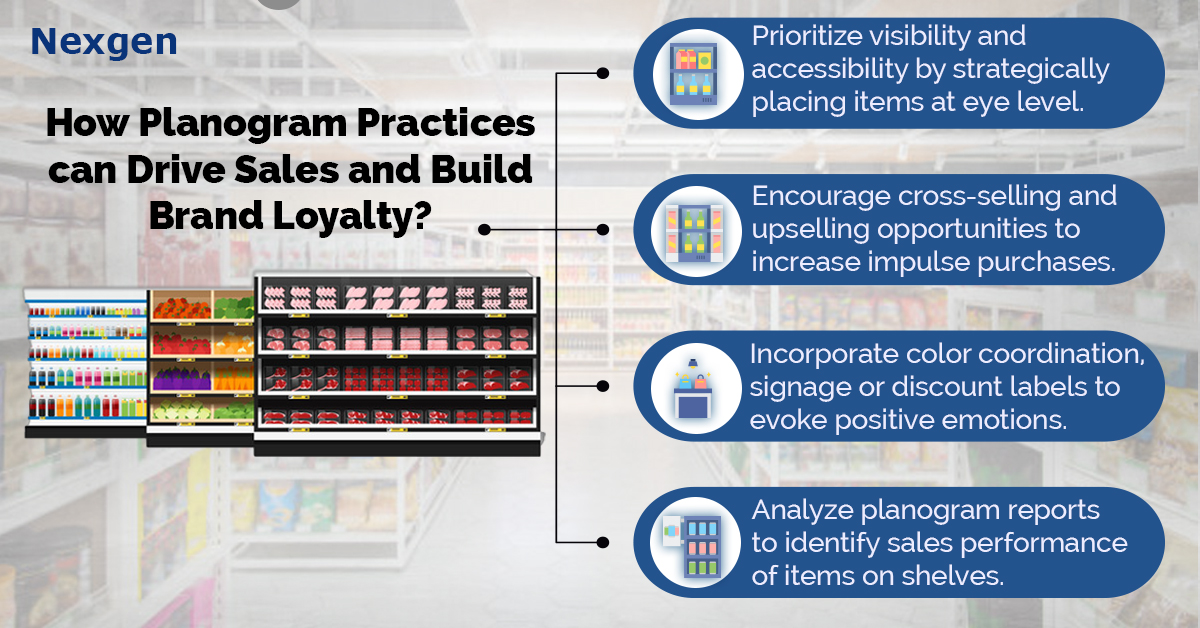In retail, every square inch of shelf space matters. Imagine as your shoppers enter, they are welcomed with a carefully curated display showcasing the latest seasonal arrivals, mannequins dressed in stylish ensembles, inspiring your shoppers with outfit ideas for various occasions. Shelf planning solutions, such as planograms guide the placement of each item, ensuring a visually appealing and easy-to-navigate display that encourages customers to start their shopping journey on a positive note. When executed effectively, planogram practices can not only drive sales but also foster brand loyalty among customers. Let us delve deeper into how this strategy works in retail.

1. Enhancing visibility and accessibility.
Effective planograms prioritize visibility and accessibility of products. By strategically placing items at eye level or within easy reach, retailers can increase the likelihood of customers noticing and purchasing them. This ensures that popular or high-margin products receive the attention they deserve, driving sales and revenue.
Furthermore, optimizing product placement based on consumer behavior and preferences can lead to an enticing hopping experience. When customers can quickly find what they are looking for, they are more likely to make a purchase and leave satisfied. This positive experience encourages repeat visits and builds trust in the brand.
2. Encouraging cross-selling and upselling.
A well-designed planogram not only focuses on individual products but also considers how they complement each other. By grouping related items together, retailers can encourage cross-merchandising and upselling opportunities. For example, placing chips next to dips or batteries next to electronic devices prompts customers to purchase additional items they may not have initially considered.
Moreover, strategic product placement can guide customers through the store, exposing them to a wider range of offerings and increasing the likelihood of impulse buys. This not only boosts sales but also strengthens brand affinity as customers associate the convenience and satisfaction of their shopping experience with the brand.
3. Creating a memorable shopping experience.
Planograms are not just about selling products; they are about crafting an immersive and memorable shopping experience. By incorporating visual merchandising techniques, such as color coordination, signage, discount labels and seasonal displays, retailers can capture the attention of shoppers and evoke positive emotions.
Aesthetically pleasing displays and well-curated product arrangements not only make the shopping journey more enjoyable, but also reinforce the brand's identity and values. When customers feel emotionally connected to a brand, they are more likely to become loyal to retail stores who return repeatedly.
4. Harnessing data for continuous improvement.
The beauty of planogram practices lies in their adaptability. Retailers can gather valuable data on sales performance, customer behavior, and market trends to continually refine and optimize their planograms. By leveraging analytics tools and customer feedback, retailers can identify opportunities for improvement and tailor their merchandising strategies to meet evolving consumer demands.
Whether it is adjusting shelf layouts, refreshing product assortments, or experimenting with new promotional tactics, planograms remain effective in driving sales and building brand loyalty over time.
Overview of Nexgen POG
Nexgen POG is a robust and user-friendly cloud-based visual merchandising tool. It is designed for quick and efficient planogramming with minimal effort. Planogram in retail can be designed by easily dragging and dropping the products. The multi-device compatibility feature of POG allows you to obtain, share and edit planogram on any device, including your phone. It helps in designing store-specific planograms for increased product visibility and sales.
Get Your Free Trial Now!